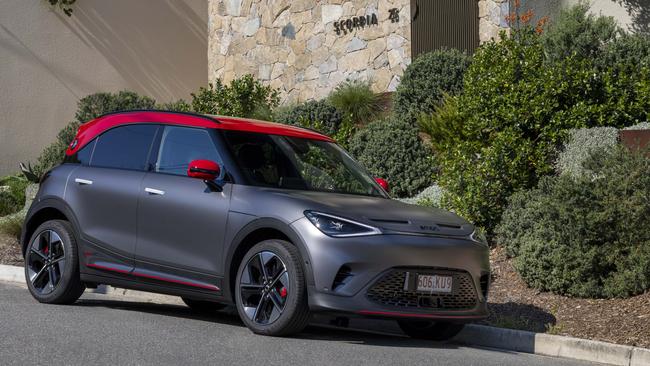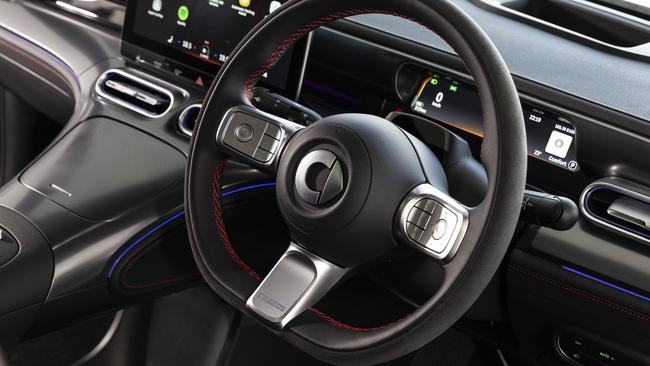First drive: 2024 Smart #1 EV
This attractive and quirky new electric car makes a case for going against the flow by taking a risk on a new player.
New Cars
Don't miss out on the headlines from New Cars. Followed categories will be added to My News.
Is this the future of motoring?
When electric cars have the same hardware, prices and practicality, they will likely be separated by styling, software and ownership elements attracting different customers.
So it goes with the return of Smart cars in Australia – not as original and tiny city cars,
but clones of practical four-door EVs originally built by other brands.
Smart’s new cars are a joint venture between Mercedes-Benz (which designed the car) and Volvo’s parent company Geely (which builds them in China).

The Smart #1 – pronounced “hashtag one” – has the same underpinnings as a few electric cars including the new Volvo EX30.
It undercuts Volvo’s offering by a handy $10,000, but there is a catch.
Smart will only be sold through three Mercedes dealerships in Australia – showrooms in Brisbane, Melbourne and Sydney owned and operated by international dealer giant LSH Auto.

That’s a win if you’re in Brisbane, where the Smart showroom is magnificent. But folks outside capital cities on the Eastern Seaboard miss out.
There are two cars to choose from for now, the hatchback-shaped Smart #1 (pronounced “hashtag one”) we focused on, and the sleeker Smart #3.
The range starts with a Smart #1 Pro+ priced from $54,900 plus on-road costs (about $57,000 drive-away.
Standard equipment includes a rear-mounted electric motor with 200kW and 343Nm of power.
A 12.8-inch touchscreen has smartphone mirroring and a smattering of AI features including a fox-shaped avatar that has cute animations but no more functionality than many modern cars.
The Smart has features such as LED headlights, a panoramic sunroof, powered tailgate and a full suite of driver assistance tech.
A five-year warranty is par for the course, though a decision to limit coverage to 150,000 kilometres feels mean-spirited in an age of unlimited-mileage guarantees.
Mid-grade Premium models are $58,900 plus on-roads (about $61,000 drive-away), adding luxury touches such as leather trim, a 13-speaker Beats stereo and 10-inch head-up display.

The range-topping Smart #1 Brabus is $67,900 plus on-road costs (about $70,000 drive-away, again $10,000 under the equivalent Volvo), delivering 315kW and 584Nm thanks to a second electric motor mounted up front.
Extra grunt reduces its 0-100km/h time to 3.9 seconds, and it also brings sporty additions such as suede-like Alcantara for the seats and steering wheel. All three Smart #1 models have a 66kWh battery that delivers 400km of range in the punchy Brabus, and up to 440km in the more efficient Premium.
Other features include a digital key you can transmit to the phones of friends or family who need to borrow the car.
The cabin impresses with Mercedes-derived design and materials, as well as an eye for practicality that includes a sliding rear seat and more storage spaces than we care to count.
It has a sweet letterbox-shaped driver display behind the steering wheel that looks great and is less distracting than rival cars that rely on the centre screen for key readouts.

There is plenty of room for bigger or taller drivers, and a wide range of adjustment that lets you get comfortable behind the wheel.
It might have the same running gear as a Volvo but ordinary seats in the Smart aren’t a match for the Swedish brand.
Our test drive of the Smart took place in a convoy from Brisbane to Byron Bay.
Highway running with several stops offered a limited chance to understand the car’s dynamic qualities.
But we can say that the standard car’s 200kW thrust is more than adequate in day to day driving, and that the Brabus’ 315kW punch returns shocking pace in the real world.
That said, the Brabus doesn’t drive like a performance car. There’s too much pitch and roll to the suspension, and the car shifts its weight noticeably when you ask for a change in pace or direction.
There’s lag in the throttle response – which is unusual for an electric car – the eco tyres offer limited purchase when pushed, and there is a lack of natural feedback through the steering or brakes – it can feel a little imprecise, as though you’re playing a video game.
We were also annoyed by over-reliance on its main touchscreen and overly sensitive lane keeping assistance tech.
It’s hard to shake a suspicion that despite having the same core ingredients as the impressive Volvo EX30, the result isn’t quite as sweet.
Originally published as First drive: 2024 Smart #1 EV



